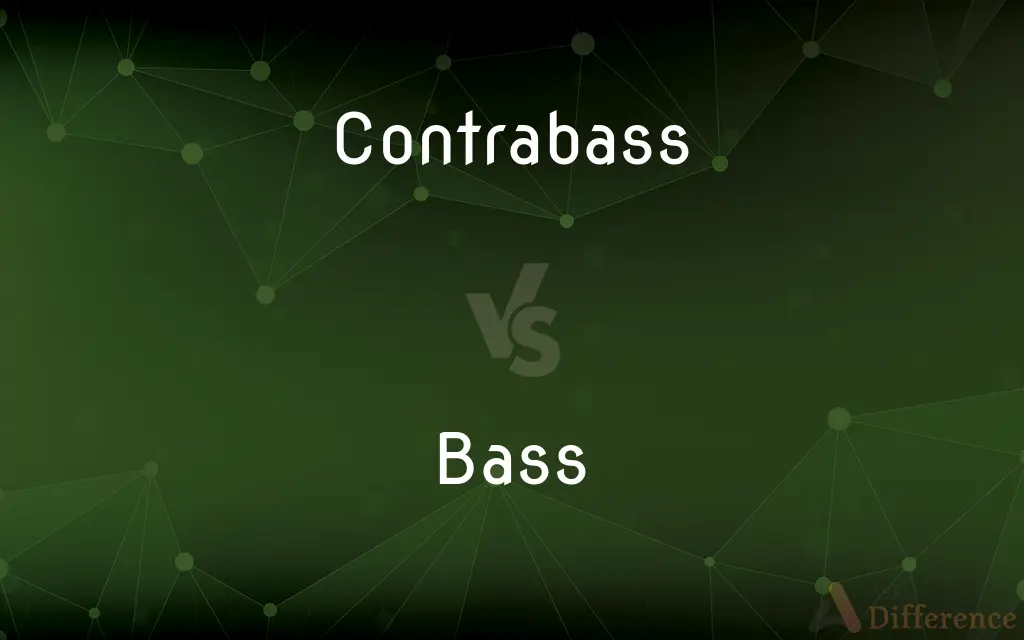Contrabass vs. Bass — What's the Difference?
Edited by Tayyaba Rehman — By Fiza Rafique — Updated on April 5, 2024
Contrabass, with its deeper sound, serves in orchestras and jazz bands, often playing an octave lower than the bass, which anchors harmony in various music genres with a less profound tone.

Difference Between Contrabass and Bass
Table of Contents
ADVERTISEMENT
Key Differences
Contrabass, also known as double bass, is a string instrument that produces the lowest pitch in the string family, making it essential in orchestras for its deep, resonant sounds. Whereas bass can refer to various instruments, including bass guitar and bass voice, known for their lower pitches but not as deep as the contrabass.
Contrabass is played using a bow or by plucking the strings, allowing it to produce a wide range of tones from soft and mellow to loud and aggressive, essential for dynamic orchestral music. On the other hand, bass instruments, especially the electric bass guitar, are primarily plucked and are central to the rhythm section in bands, contributing to the music's groove and foundation.
In classical music, the contrabass provides a harmonic and rhythmic foundation, playing a crucial role in the ensemble by supporting other instruments. Bass, particularly in modern bands, also serves a foundational role but is more prominent and soloistic, often leading the harmonic progressions and rhythms.
The physical size of the contrabass is larger, requiring players to stand or use a stool, which affects the playing technique and posture. Whereas bass instruments like the bass guitar are smaller and more portable, allowing musicians to play standing or sitting without significantly altering their technique.
The contrabass is tuned in fourths, with strings typically tuned to E1, A1, D2, and G2, which contributes to its deep sound. On the other hand, bass guitars are also tuned in fourths but an octave higher, making them less deep but more versatile in higher pitches.
ADVERTISEMENT
Comparison Chart
Pitch Range
Deepest in string family, tuned an octave lower
Lower pitch but higher than contrabass
Use in Music
Orchestras, jazz for deep, resonant sounds
Various genres, for harmony and rhythm
Playing Method
Bowed or plucked, standing or with stool
Primarily plucked, played standing or sitting
Role in Music
Harmonic and rhythmic foundation in ensembles
Rhythm section, leads harmonic progressions
Tuning
Tuned in fourths (E1, A1, D2, G2)
Tuned in fourths, an octave higher
Compare with Definitions
Contrabass
A large string instrument producing the lowest pitch in the string family.
The contrabass added a rich depth to the orchestra's sound.
Bass
Tuned in fourths but an octave higher than the contrabass.
After tuning his bass, he joined the rehearsal, perfectly in sync with the band.
Contrabass
Played either by bowing or plucking the strings.
She practiced a difficult passage on her contrabass, carefully bowing each note.
Bass
Refers to various instruments with lower pitch ranges, including bass guitar.
The band's bass player set the groove with a catchy riff.
Contrabass
Tuned in fourths, typically to E1, A1, D2, and G2.
He tuned his contrabass carefully before the concert began.
Bass
Central to the rhythm section in bands, contributing to the music's foundation.
Her bass playing was so powerful it drove the entire performance.
Contrabass
Requires a specific technique due to its size.
Learning to play the contrabass involves mastering its unique standing posture.
Bass
Smaller and more portable than the contrabass.
He carried his bass guitar everywhere, practicing whenever he could.
Contrabass
Essential in orchestras and jazz bands for its resonant sounds.
His contrabass solo was the highlight of the jazz band's performance.
Bass
Often played by plucking the strings, especially in modern music.
He plucked the bass guitar strings with precision, adding to the song's energy.
Contrabass
Contrabass (from Italian: contrabbasso) refers to several musical instruments of very low pitch—generally one octave below bass register instruments. While the term most commonly refers to the double bass (which is the bass instrument in the orchestral string family, tuned lower than the cello), many other instruments in the contrabass register exist.
Bass
The lowest adult male singing voice
His bass voice rings out attractively
Contrabass
See double bass.
Bass
Denoting the member of a family of instruments that is the lowest in pitch
A bass clarinet
Contrabass
Pitched an octave below the normal bass range.
Bass
The low-frequency output of a radio or audio system, corresponding to the bass in music.
Contrabass
The part or section one octave lower than bass.
Bass
The common European freshwater perch.
Contrabass
Double bass; string bass.
Bass
Any of a number of fish similar to or related to the perch.
Contrabass
Any of the several contrabass instruments.
Bass
Another term for bast
Contrabass
The person or instrument performing the contrabass part.
Bass
Any of various North American freshwater fishes of the family Centrarchidae, especially the largemouth bass and the smallmouth bass.
Contrabass
The lowest stringed instrument of the violin family; the double bass; - also applied to any instrument of the same deep range as the stringed double bass; as, the contrabass ophicleide; the contrabass tuba or bombardon.
Bass
Any of various marine fishes especially of the families Serranidae and Moronidae, and including the sea basses and the striped bass.
Contrabass
Largest and lowest member of the violin family
Bass
A male singing voice of the lowest range.
Contrabass
Pitched an octave below normal bass instrumental or vocal range;
Contrabass or double-bass clarinet
Bass
A singer who has such a voice.
Bass
An instrument, especially a double bass or bass guitar, that produces tones in a low register.
Bass
A vocal or instrumental part written in a low register.
Bass
A low-pitched sound or tone
The deep bass of trucks braking on the highway nearby.
Bass
The tones in the lowest register of an instrument
A piano that is weak in the treble but has a very full sound in the bass.
Bass
Having a deep tone.
Bass
Low in pitch.
Bass
Of sound, a voice or an instrument, low in pitch or frequency.
The giant spoke in a deep, bass, rumbling voice that shook me to my boots.
Bass
A low spectrum of sound tones.
Peter adjusted the equalizer on his audio equipment to emphasize the bass.
Bass
A section of musical group that produces low-pitched sound, lower than the baritone and tenor.
The conductor preferred to situate the bass in the middle rear, rather than to one side of the orchestra.
Bass
One who sings in the bass range.
Halfway through middle school, Edgar morphed from a soprano to a bass, much to the amazement and amusement of his fellow choristers.
Bass
(musical instrument) An instrument that plays in the bass range, in particular a double bass, bass guitar, electric bass or bass synthesiser.
The musician swung the bass over his head like an axe and smashed it into the amplifier, creating a discordant howl of noise.
Bass
The clef sign that indicates that the pitch of the notes is below middle C; a bass clef.
The score had been written without the treble and bass, but it was easy to pick out which was which based on the location of the notes on the staff.
Bass
The perch; any of various marine and freshwater fish resembling the perch, all within the order of Perciformes.
Bass
The fibrous inner bark of the linden or lime tree, used for making mats.
Bass
Fibers from other plants, especially palm trees
Bass
Anything made from such fibers, such as a hassock, basket or thick mat.
Bass
To sound in a deep tone.
Bass
An edible, spiny-finned fish, esp. of the genera Roccus, Labrax, and related genera. There are many species.
Bass
The two American fresh-water species of black bass (genus Micropterus). See Black bass.
Bass
Species of Serranus, the sea bass and rock bass. See Sea bass.
Bass
The southern, red, or channel bass (Sciæna ocellata). See Redfish.
Bass
The linden or lime tree, sometimes wrongly called whitewood; also, its bark, which is used for making mats. See Bast.
Bass
A hassock or thick mat.
Bass
A bass, or deep, sound or tone.
Bass
The lowest part in a musical composition.
Bass
Deep or grave in tone.
Bass
To sound in a deep tone.
Bass
The lowest part of the musical range
Bass
The lowest part in polyphonic music
Bass
An adult male singer with the lowest voice
Bass
The lean flesh of a saltwater fish of the family Serranidae
Bass
Any of various North American freshwater fish with lean flesh (especially of the genus Micropterus)
Bass
The lowest adult male singing voice
Bass
The member with the lowest range of a family of musical instruments
Bass
Nontechnical name for any of numerous edible marine and freshwater spiny-finned fishes
Bass
Having or denoting a low vocal or instrumental range;
A deep voice
A bass voice is lower than a baritone voice
A bass clarinet
Common Curiosities
How does the size of the contrabass affect its playability?
The larger size of the contrabass requires players to stand or use a stool, impacting the technique and posture needed for playing.
Can the contrabass be played with a bow?
Yes, the contrabass can be played both by bowing and plucking, allowing for a range of expressive sounds.
Is it difficult to transition from playing the bass to the contrabass?
Transitioning between the two can be challenging due to differences in size, technique, and tuning.
What is the main difference between contrabass and bass?
The main difference lies in their pitch range and use; contrabass produces deeper sounds and is used in orchestras, while bass has a slightly higher pitch and is versatile across music genres.
Can bass instruments lead in music compositions?
Yes, especially in modern music, bass instruments can lead harmonic progressions and are often more prominent and soloistic.
What makes the bass guitar popular in modern music?
Its versatility, portability, and ability to fit into various musical genres make the bass guitar popular in modern music.
Do contrabass and bass require different playing techniques?
Yes, the physical differences and tuning of the instruments necessitate different playing techniques.
Which instrument is more challenging to learn for beginners?
The contrabass may be more challenging due to its size and the technique required for playing standing or with a stool.
Is the bass guitar considered a type of bass?
Yes, the bass guitar is a type of bass instrument, known for its role in the rhythm section of bands across various music genres.
How do the roles of contrabass and bass differ in a band or orchestra?
The contrabass provides a harmonic and rhythmic foundation in ensembles, while the bass leads harmonic progressions and rhythms in the rhythm section.
What tuning is typical for the contrabass?
The contrabass is typically tuned in fourths, with strings tuned to E1, A1, D2, and G2.
How does the tuning of bass instruments affect their sound?
Tuning affects the pitch range and versatility of the instruments, with the contrabass tuned lower for deeper sounds.
Are there specific genres where the contrabass is preferred?
Yes, the contrabass is preferred in classical music and jazz for its deep, resonant sounds.
Can both contrabass and bass be used in jazz music?
Yes, both can be used in jazz, though the contrabass is more commonly associated with traditional and swing jazz styles.
Why is the contrabass important in an orchestra?
Its ability to produce the lowest pitches adds depth and foundation to the orchestral sound, supporting other instruments harmonically and rhythmically.
Share Your Discovery

Previous Comparison
Competitiveness vs. Competitive
Next Comparison
Notion vs. TrelloAuthor Spotlight
Written by
Fiza RafiqueFiza Rafique is a skilled content writer at AskDifference.com, where she meticulously refines and enhances written pieces. Drawing from her vast editorial expertise, Fiza ensures clarity, accuracy, and precision in every article. Passionate about language, she continually seeks to elevate the quality of content for readers worldwide.
Edited by
Tayyaba RehmanTayyaba Rehman is a distinguished writer, currently serving as a primary contributor to askdifference.com. As a researcher in semantics and etymology, Tayyaba's passion for the complexity of languages and their distinctions has found a perfect home on the platform. Tayyaba delves into the intricacies of language, distinguishing between commonly confused words and phrases, thereby providing clarity for readers worldwide.
















































